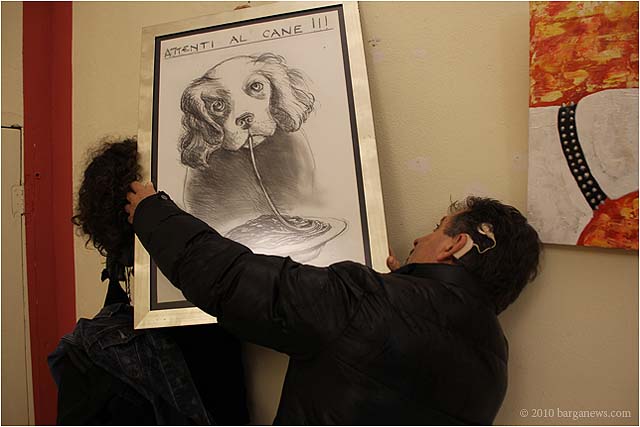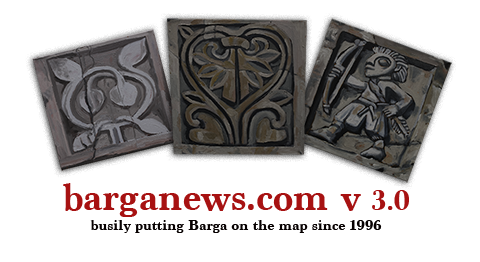 When 73 artists join forces to present nearly 100 paintings, sculptures, videos and poems on a single theme, the result can’t really be called something as limited as a mostra (“exhibition”). It’s more in the nature of an encyclopaedic survey. In the case of Cave Canem, the event that opened in three Barga venues November 1, the encyclopedia’s sweep covers virtually everything known, suspected or fantasized about dogs – mostly, but not exclusively, in their relations to human beings.
When 73 artists join forces to present nearly 100 paintings, sculptures, videos and poems on a single theme, the result can’t really be called something as limited as a mostra (“exhibition”). It’s more in the nature of an encyclopaedic survey. In the case of Cave Canem, the event that opened in three Barga venues November 1, the encyclopedia’s sweep covers virtually everything known, suspected or fantasized about dogs – mostly, but not exclusively, in their relations to human beings.
Like our canine companions themselves, the works come in such diverse sizes, shapes and moods that generalizations are all but impossible. On one wall of the Marzocco Gallery on Piazza Angelio, a self-satisfied chihuahua – sketched onto yellowed paper by Lucia Pedri with draughtsmanship so precise that it recalls Leonardo da Vinci – swings a startled lizard by the tail. Across the room leers an animal roughly 30 times the Chihuahua’s dimensions, with a torso and muzzle seemingly borrowed from a cat and a feral hog, and the muscle-bound arms of Popeye the Sailor.
There are modest dogs and celebrated dogs, among them the poet Giovanni Pascoli’s constant companion“Guli,” pictured in two early 20th-century photos and a simple line-drawing by Pascoli. There is a dog who distinctly resembles Tony Blair. There is Paola Marchi’s wryly contemplative astral dog in the constellation known as “Canis Major”. There are, inevitably, odes to dog paw prints in wet cement and dog doodoo in the footpath. There are poodles and Afghans, beagles and Jack Russells, in poses that range from the masochistic and the maudlin to the cuddly and the kitsch.
Few subjects, after all, are better suited to kitsch than the sentimental baggage carried by doggydom in its ancient status as humankind’s best friend and guardian. Fido, “the faithful one,” was the favourite name bestowed on dogs in the Roman Empire and remains a favourite 2,000 years later.
The Barga artist Keane (a.k.a “Doggybag) – who curated the collection with painter Sandra Rigali and photographers Georgia Madiai and Caterina Salvi – pays homage to that venerable lineage in the show’s title. It translates from the Latin as “Beware of Dog,” the warning famously inscribed on a ceramic plaque unearthed in a house buried by volcanic ash at Pompei in 79 AD.
But if there are time-honoured conventions aplenty in Cave Canem, there are also myriad ingenious twists on them. In one hallway, a row of jarringly abstract Dadaist dogs snarl and snap, among them a multi-headed cur who might be taken for Cerberus, the guardian of infernal Hades in classical Greece, except that the Greek version had three heads and painter Alessandro Luschi’s has four.
Poets Kerry Bell and Siona Dunn take aim at the awkward bit parts assigned to dogs by anthropomorphizing humans in their own psychodramas. Below a soft-focus photo of a Jungian canine archetype, Bell writes, “I’m not a dog person but if I were she’d look like this.” Dunn speaks of a sister who
Can make the black dog suffer and whimper
With words of lash and words of dominion
If any single element links these enormously varied works, it is the observation that dogs are among Nature’s great observers – keeping their eyes trained on their two-legged erstwhile masters, trying to second guess a far more erratic species of Mammalia than their own. Take a close look at faces of the dogs on these walls, notably in Luca Galeotti’s close-up photo of a terrier’s eye and Leslie Millar’s painting of her mother’s Labrador. They’re watching you closely, following your movements and reactions, as well they should given the millennial record of human vagaries.
Dogs, after all, are burdened with two identities: They are who they are, like any living creature. But they are also what we insistently try to make of them.
Cave Canem can be visited at Barga’s Galleria Marzocco, Galleria Comunale and Museo della Memoria until November 7, when it will climax with live music, a book presentation…and a dog show in Piazza Angelio
Article by Frank Viviano





















